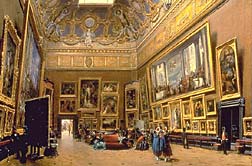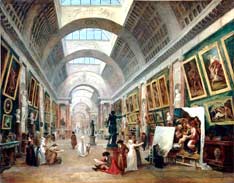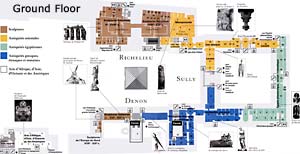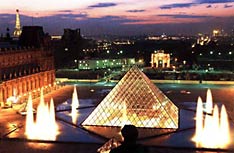Museum
Sunday, December 19, 2010
Omani French Museum
Nostalgia about an era gone by, the 19th century in particular, is evoked in this rather interesting museum. Tourists are able to learn a great deal from the exhibits and galleries showcasing Oman’s unique relationship with France, a former colonial power. The pictures of early French diplomats are also on display along with an interesting collection of postage stamps. This museum was opened in 1992 in a house almost 200 years old which once served as the French Consul.
louver museum

Evening view, courtyard of the Louvre and I.M. Pei pyramid. (Photographer: Benh Lieu Song.)
Louvre {loov'-ruh} — a French palace and the national art museum of France.
Located in Paris, the Louvre is one of the largest palaces in the world and, as a former residence of the kings of France, one of the most illustrious. It exemplifies traditional French architecture since the Renaissance, and it houses a magnificent collection of ancient and Western art.
The Palace
The first Louvre was a fortress built at the beginning of the 13th century by Philip II Augustus to defend the Seine below Paris against the Normans and English. It consisted of a thick cylindrical donjon (dungeon) surrounded by towered walls. This château, enlarged and embellished by Charles V in the 14th century, was sacrificed in the 16th century at the end of the reign of Francis I in order to make room for a new Renaissance structure of the same size. Only the west wing and part of the south wing of the projected palace, conceived by the architect Pierre Lescot and decorated with sculptures by Jean Goujon, were finished.
In 1564 Catherine de Médicis had her architect, Philibert Delorme, build a little château in a neighboring field to the west called the Tuileries. It was then decided to create a grandiose royal residence by joining the Louvre and the Palais des Tuileries by a series of buildings. The most important is the Grande Galerie built along the Seine in the reign of Henry IV.
In the 17th century Louis XIII and his minister Richelieu extended Lescot's west wing northward by adding the majestically domed Pavillon de l'Horloge (clock pavillion) by Jacques Lemercier and recreating Lescot's building beyond it. Under Louis XIV and his minister Colbert, the Cour Carrée, a great square court, was constructed by Louis Le Vau. The east façade of the east wing was later given a classical colonnade by Le Vau and Claude Perrault. The royal apartments were sumptuously decorated by Charles Le Brun and others, as the Galerie d'Apollon still bears witness. The Louvre was abandoned as a royal residence when Louis XIV moved the court to Versailles in 1682.
After the Revolution of 1789, Napoleon I, later kings, and Napoleon III lived in the Tuileries. The Louvre was used for offices and a museum. Along the Rue de Rivoli, Napoleon I began a wing parallel to that of Henry IV along the Seine. Napoleon III finished the wing, thus closing the great quadrilateral.
A few years later, during the uprising of the Paris Commune in 1871, the Tuileries was burned. Paradoxically, the disappearance of the Tuileries, which had originally brought about the extension of the Louvre, opened the admirable perspective that now stretches from the Arc du Carrousel west through the Tuileries Gardens and the Place de la Concorde to the Place Charles de Gaulle.
 Le Salon Carré, en 1865, au Musée du Louvre by Giuseppe Castiglione Canvas - H 0,69 m ; L 1,03 m (27"H x 40.5"W) | |
In the late 1980s the Louvre embarked upon an aggressive program of renovation and expansion. When the first plans by the Chinese-American architect Ieoh Ming Pei were unveiled in 1984, they included a glass pyramid in the central courtyard that would serve as the museum's main entrance. Despite drawing protests before the fact, since its opening in 1989 the pyramid has proven remarkably effective in accommodating the large numbers of visitors, and has even become a relatively beloved landmark of the city. In November 1993, to mark its 200th anniversary, the museum unveiled the Richelieu wing in the quarters that had been vacated, grudgingly, by the Ministry of Finance in 1989. This expansion, which completed the museum's occupancy of the palace complex, added 230,000 square feet (21,390 sq meters) to the existing 325,000 square feet (30,225 sq meters) of exhibition space, and allowed it to put an additional 12,000 works of art on display in 165 new rooms.
The Museum
In 1793, during the Revolution, the first state museum was opened in the Louvre, consisting of the former royal collections of painting and sculpture. It was enriched temporarily by loot from the Napoleonic wars and then permanently by purchases and gifts, including archaeological finds. More and more specialized divisions were created.
 Projet d'aménagement de la Grande Galerie du Louvre, vers 1789? by Hubert Robert, 1796 Musée du Louvre | |
The present Louvre departments include Oriental (ancient Mesopotamian) antiquities; Egyptian antiquities; Greek and Roman antiquities; sculpture from the Middle Ages to modern times; furniture and objets d'art; and paintings representing all the European schools. A section of the museum is devoted to Islamic art.
Universally famous ancient works of art in the Louvre include a statuette of the Sumerian ruler Gudea, a stele bearing Hammurabi's code, an Egyptian painted stone statue of a scribe sitting cross-legged, the Venus de Milo, and the Victory of Samothrace. Among outstanding later works are two marble Slaves by Michelangelo, the treasure of the abbey of St. Denis, and the French crown diamonds. Important paintings include the Pietà of Avignon, Leonardo da Vinci's Mona Lisa, Veronese's immense Wedding at Cana (which was badly damaged in 1992 while being installed in the newly renovated galleries), and Watteau's Embarkation for Cythera.
The school of the Louvre trains curators in history of art and archaeology. Special exhibits are indicated in the Revue du Louvre.
Archaeological Discoveries
Traces of the medieval fortress from which the present day palace originates have been uncovered. Restoration work on the Cour Carrée and the excavation required for construction of the pyramid and the Carrousel area enabled archeological digs to be undertaken, and for the various phases of occupation of the palace and its quarters to be seen.
The architectural structures of the basement will henceforth be included in the visit tours. Thus, it is possible to walk along the moats of the medieval fortress under the Cour Carrée, to pass around the base of the dungeon to get to the Salle Saint-Louis (13th century), or — when going to the underground carpark — to walk along the so-called Charles V Moats.
Amongst the items discovered during these digs, one of the most remarkable is a parade helmet belonging to Charles VI, which was reconstituted from the one hundred and sixty-nine fragments which were found scattered about. It is on display in the Salle Saint-Louis (Sully Wing).
Admission
For those who plan to visit many monuments and museums during your séjour à Paris, Discover France offers the "Museums and Monuments Card" (Carte Musées et Monuments), valid for unlimited visits and priority access to approximately 70 locations in — and near — Paris. It can also be purchased at the Paris Tourist Office (127, avenue des Champs-Elysées), at its reception offices in certain Paris train stations, at the Eiffel Tower, in the major Métro stations, or at most of the 70 attractions. Cards are available in denominations valid for either one, three, or five consecutive days.
click hear
Saturday, December 18, 2010
museum in thye world
Cafés
At the museum there are two cafés to choose from. On the ground floor there is the Espresso bar, which serves light refreshments including pastries, cakes, snacks and beverages from 10.30am-4.30pm. Highchairs are available in this cafe.There is also the top floor café, which has great views across the city. Here you can enjoy a selection of hot and cold meals, snacks, cakes and beverages. There is a children's menu and highchairs are available.
Opening hours for the top floor cafe are:
- 10.30am-4.30pm
Menus
You can contact the museum cafés to make an enquiry here.Picnic area
Our indoor picnic area with drinks machine is open daily from 10am- 4.30pm.
Shops
There are two shops in the ground floor of the museum; one is a fair trade shop - the first in a UK museum. It sells a wide range of books, jewellery, crafts, food and gift ideas from around the world. There is also a toy shop selling a full range of souvenirs, toys and books for younger visitors.You can also visit our online bookshop to buy our publications
CLICK HERE
Subscribe to:
Comments (Atom)



